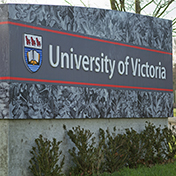University continues to plan for budget reductions
As has been previously reported in The Ring, UVic is preparing for the potential provincial cuts to university operating grants as a result of the government “challenging the advanced education sector” to find $50 million in savings in 2013–14 and 2014–15. At the same time, UVic is looking for savings to fund salary increases negotiated with its employee groups under the provincial government’s “cooperative gains” bargaining mandate.
In June, UVic President David Turpin asked all vice-presidents to incorporate a 4-per-cent cut into their 2013–14 operating budgets and to develop plans for a further reduction of up to 4 per cent in 2014–15. The Ring is providing this budget planning update to try to answer some of the questions from our community about the overall context and process:
Why does UVic have to cut its budget?
With the continuing economic uncertainty in the global economy, revenues at all levels of government are tight. This is having an effect on the funding available for the post-secondary sector across Canada and internationally. Provincial operating grants and other sources of operating revenue have not kept up with increases in educational costs. These costs are driven significantly by the single largest component of any university budget—faculty and staff salaries. University salary budgets increase each year as a result of the cumulative effect of the progression through salary ranges for many individual employees that occurs even in the absence of across-the-board salary increases. Universities are about people, and at UVic approximately 80 per cent of the university’s annual operating budget is devoted to salaries and benefits.
Why cut 4 per cent now when we won’t know what the actual reduction will be until at least spring 2013?
The provincial government has sent strong signals that there will be cuts in the advanced education budget in each of the next two years. There will also be increases in compensation for UVic employee groups resulting from the across-the-board salary increases for 2012 and 2013. While the combined effect of these on the university budget can’t yet be determined, the university is projecting a deficit, even without a reduction in UVic’s provincial operating grant. By planning for reductions now, and providing as much notice as possible, UVic can minimize negative impact on quality, capacity or services, and reduce the need for layoffs by using existing vacancies or planned retirements. The university has instituted a vacancy management strategy so that wherever possible, faculty and staff vacancies are not filled, allowing reductions to occur through attrition rather than layoffs. Implementing some of the planned reductions in the current fiscal year will also allow units to accelerate the savings and free up one-time funds to help with the transition.
What about the following year?
Given the greater uncertainty for 2014–15, units are being asked to develop plans for possible reductions in the range of up to 4 per cent. Announcement of these further cuts won’t occur until there is greater certainty of the university’s budget for the following year. The university usually finalizes budget parameters in November of each year for the following year. The current uncertainty related to provincial operating grants and compensation costs should be alleviated by then, allowing confirmation of any budget reductions at that time for 2014–15. Individual units may decide, however, to implement their plans ahead of time, particularly where these plans are part of a restructuring or change in service delivery. If the full amount of reductions implemented is not required, the unit will be in a position to reallocate any savings to its highest priorities.
What about finding efficiencies to address the government’s expectations for reductions in administrative and other costs not directly related to program delivery?
The last two years of cuts have meant that many administrative efficiencies have already been identified and implemented, so over the last few months a variety of different approaches have been explored, including optimizing resources and applying “smart growth” principles such as consolidating undersubscribed and duplicate sections of courses without shutting out students or increasing faculty course loads, and removing scheduling bottlenecks to free up space for more students without building more classrooms; looking to reduce costs by sharing and standardizing services like couriers, travel or educational technology; and reducing energy consumption across campus. The university is also in discussions with the Province and other post-secondary institutions to determine if there are opportunities to reduce costs through enhanced purchasing power and sharing information technology infrastructure and licenses.
What is being done to address the provincial funding situation?
The Opportunity Agenda (see “Research universities set out an ‘Opportunity Agenda for BC’”) proposes a practical plan to expand post-secondary opportunities for young people, close the skills gap and create jobs. The agenda that has been put forward by the presidents of BC’s six research-intensive universities is predicated on the provincial government maintaining operating grants for the post-secondary sector and increasing funding over time. The presidents will continue to advocate strongly for not proceeding with the potential reductions announced in the last budget.
How are decisions on budget reductions being made and communicated?
The Integrated Planning Committee, led by the provost and involving all of the university’s vice-presidents and associate vice-presidents, outlines institutional priorities to ensure that resources are allocated in a manner consistent with the objectives of the strategic plan. Some areas of highest institutional priority such as financial aid and scholarships for both undergraduate and graduate students, and library acquisitions have been protected from cuts. Deans, directors and heads of administrative units have been working with their respective vice-president to identify possible reductions that can be achieved with as little impact as possible on the university’s commitment to excellence, its teaching, research and service to the community mission, and its strategic priorities. Decisions made at the unit level will be communicated to faculty and staff by their unit heads. Unit budget reduction plans will be implemented throughout the next year keeping in mind the university’s goal of minimizing the impact on quality of programs and on students, faculty and staff.
A budget planning website containing many of the key documents in the process has been created at www.uvic.ca/budgetplanning/.




